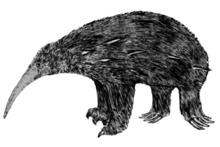Zaglossus hacketti
| Zaglossus hacketti Temporal range: Pleistocene | |
|---|---|
 | |
| Scientific classification | |
| Kingdom: | Animalia |
| Phylum: | Chordata |
| Class: | Mammalia |
| Order: | Monotremata |
| Family: | Tachyglossidae |
| Genus: | Zaglossus |
| Species: | †Z. hacketti |
| Binomial name | |
| Zaglossus hacketti Glauert, 1914 | |
Zaglossus hacketti is an extinct species of long-beaked echidna from Western Australia that is dated to the Pleistocene. It is known only from a few bones.[1] It was about 1 m long[1] and probably weighed about 30 kg (66 lb).[2] This makes it the largest monotreme known to have ever lived. Due to the lack of cranial material, placement of Z. hacketti into the modern long-beaked echidna genus Zaglossus is uncertain.[1][3]
Description
At around 1 metre long, 0.5 metres tall and about 30 kg, Z. hacketti was the largest monotreme known to have existed.[1] Z. hacketti had longer, straighter legs than any of the modern echidnas. Augee (2006) speculates that this feature made the animal more adept at traversing through thickly wooded forests.[1]
Discoveries
Fossils of Z. hacketti have been discovered in Mammoth Cave, Western Australia. The material is poor, mostly vertebra and leg bones, and the cranial material is completely absent, making Z. hacketti's placement into the genus Zaglossus uncertain.[1] Some of the fossils have incisions and burn marks, suggesting that Z. hacketti was at least occasionally hunted by humans.[4]
Aboriginal rock art found in Arnhem Land in the Northern Territory may represent Z. hacketti or the extant western long-beaked echidna.[5]
References
- 1 2 3 4 5 6 Augee, M. L.; Gooden, B.; Musser, A. (January 2006). Echidna: Extraordinary Egg-laying Mammal. Csiro Publishing. pp. 18–20. ISBN 978-0-643-09204-4. OCLC 65199910.
- ↑ "Zaglossus hacketti - extinct giant echidna". Megafauna. Tourism Western Australia. Archived from the original on 2014-01-26. Retrieved 2014-04-28. External link in
|work=(help) - ↑ Siegel, J. M.; Manger, P. R.; Nienhuis, R.; Fahringer, H. M.; Shalita, T.; Pettigrew, J. D. (June 1999). "Sleep in the platypus" (PDF). Neuroscience. 91 (1): 391–400. doi:10.1016/S0306-4522(98)00588-0. PMID 10336087.
- ↑ "Incisions, breakages and charring, some probably man-made, in fossil bones from Mammoth Cave, Western Australia". Taylot & Francis Online. Alcheringa: An Australasian Journal of Palaeontology. External link in
|work=(help) - ↑ "Megafauna cave painting could be 40,000 years old". www.abc.net.au. 2010-05-31. Retrieved 2010-05-31.; Gunn, R. C. et al. "What bird is that?" Australian Archaeology 73(2011):1-12.
- Long, J. A.; Archer, M.; Flannery, T.; Hand, S. (2002). Prehistoric Mammals of Australia and New Guinea: One Hundred Million Years of Evolution. Johns Hopkins University Press. p. 107. ISBN 978-0-8018-7223-5. OCLC 49860159.